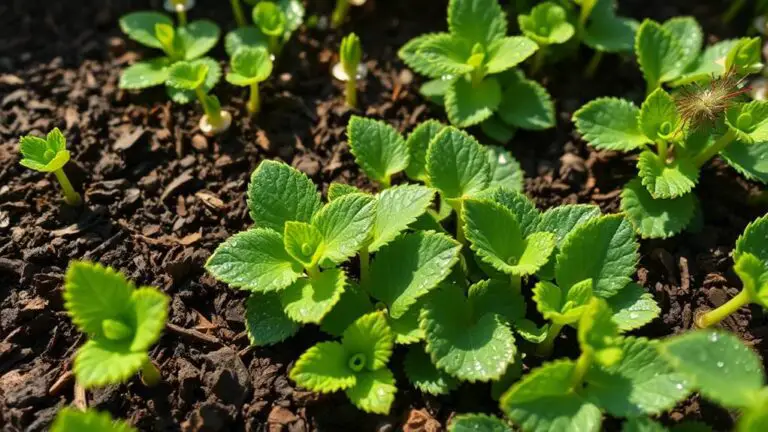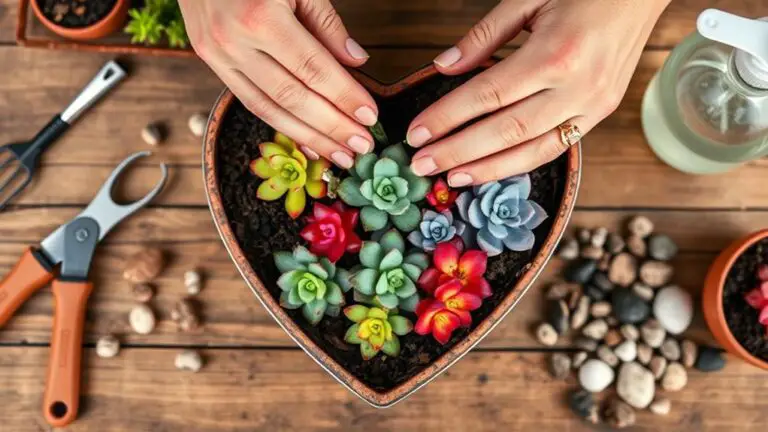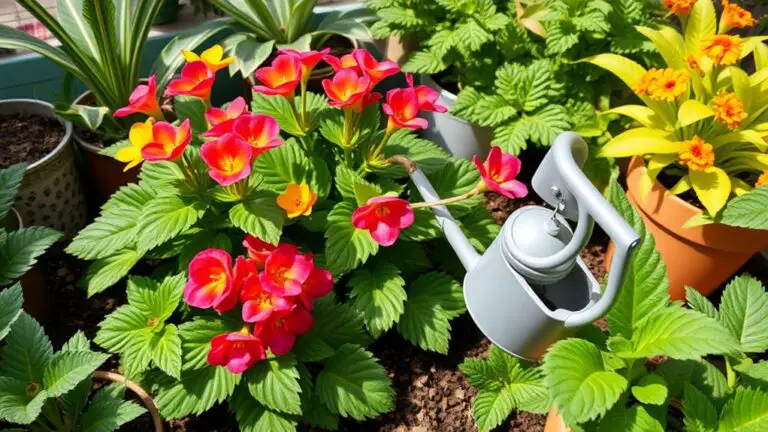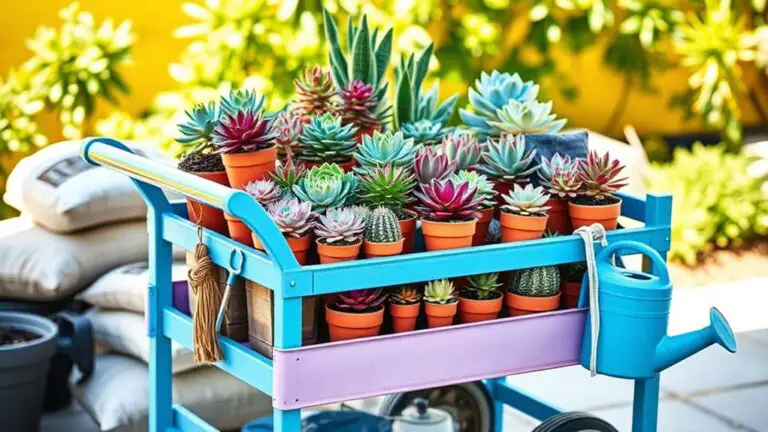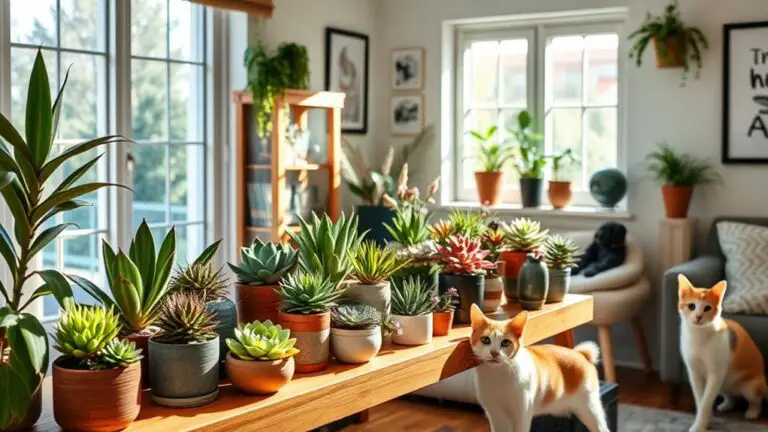7 Hardy Outdoor Succulents for Every State
Transforming your garden into a vibrant oasis with hardy outdoor succulents is easier than you think. Whether you live in a frigid northern state or a sun-soaked southern one, there are succulents that can thrive in your unique climate. Imagine Sempervivum and Sedum Spurium bringing life to your cold-weather garden, or Graptopetalum Paraguayense and Pachyveria Pachytoides standing strong against drought. But what makes these plants so resilient and visually appealing? Let's explore the characteristics that make each of these seven succulents perfect for your specific environment.
Sempervivum (Hens and Chicks)
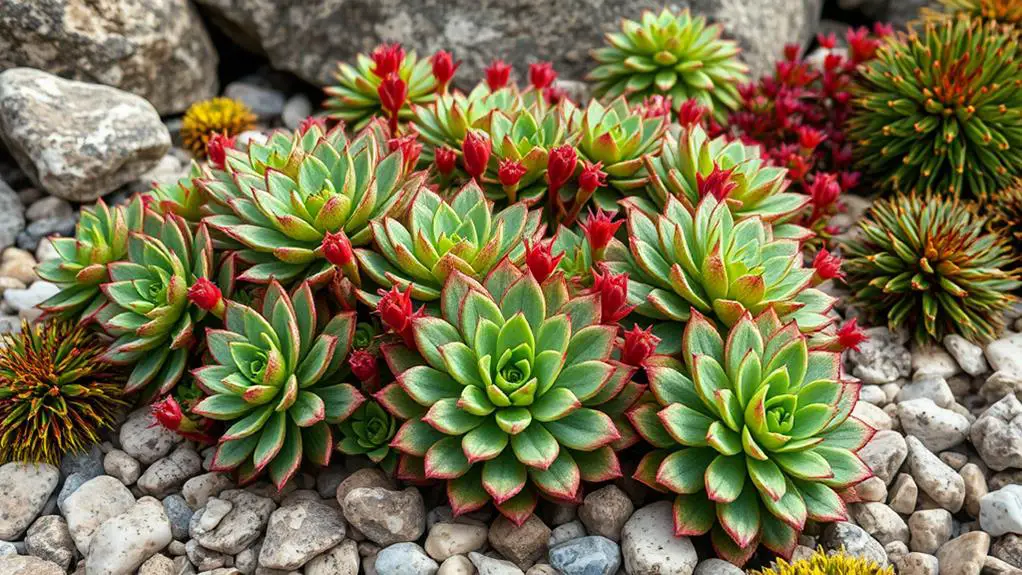
Sempervivum, commonly known as Hens and Chicks, is a robust succulent that thrives in harsh conditions, enduring temperatures as low as -30°F (Zone 4).
These hardy, cold-hardy succulents are perfect for your outdoor gardens because they can handle extreme weather without a hitch.
You'll love how Sempervivum forms dense mats through offsets, making it an excellent ground cover.
These perennial succulents produce charming rosette-shaped succulents that can change color with the seasons. In winter, they often turn a deep red, a natural defense against the cold.
This color change adds a vibrant touch to your garden, even in the colder months.
Planting Sempervivum is straightforward. They require well-drained soil and are incredibly low-maintenance.
They thrive in poor soil conditions and need little to no fertilization.
With over 700 varieties available, you can find a range of colors and textures to suit your taste.
Adding Sempervivum to your garden means you'll have a resilient and beautiful plant that provides year-round interest.
Whether you use them in rock gardens or low-water landscapes, these plants will flourish, giving you a stunning and hassle-free ground cover solution.
Sedum Spurium
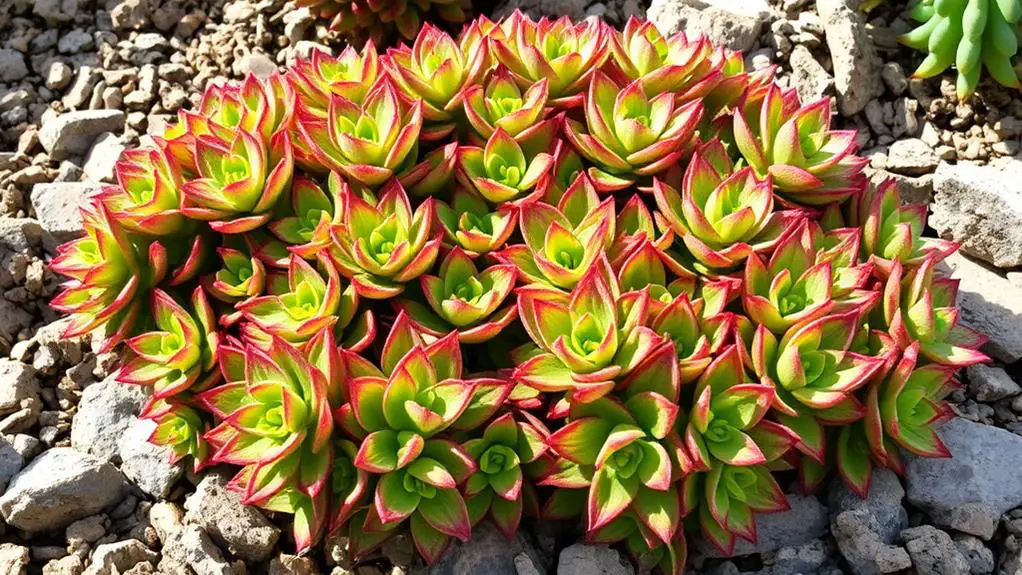
Next, let's talk about Sedum Spurium, a succulent that's tough enough to handle temperatures as low as -30°F (-34°C).
This plant forms thick mats of green leaves and bursts into red blooms in the summer, making your garden pop with color.
It's perfect for ground cover, spreading quickly and thriving even in poor, well-drained soils.
Extreme Temperature Tolerance
When it comes to extreme temperature tolerance, Sedum Spurium stands out with its remarkable resilience. This hardy succulent can handle cold weather as low as -30°F (-34°C), making it perfect for extreme climates. Its ability to survive such harsh conditions guarantees your garden stays vibrant all year round.
Sedum Spurium isn't just about surviving the cold; it also thrives in low-water landscapes thanks to its impressive drought resistance. It can endure long dry periods, making it ideal for areas that don't get much rain.
Planting Sedum in well-draining soil is essential, as it helps prevent root rot and keeps the plant healthy.
One of the most appealing aspects of Sedum Spurium is its vibrant red flowers that bloom in the summer. These flowers add a splash of color to your garden, even when temperatures drop. For novice gardeners, it's a great choice due to its minimal maintenance needs.
Consider these key points:
- Cold Tolerance: Survives temperatures as low as -30°F (-34°C).
- Drought Resistance: Thrives in dry conditions.
- Low Maintenance: Ideal for beginner gardeners.
- Colorful Blooms: Produces vibrant red flowers in summer.
With Sedum Spurium, your garden will be both beautiful and resilient.
Dense Ground Cover
Creating a lush, low-maintenance landscape is achievable with Sedum Spurium, often known as two-row stonecrop. This hardy outdoor succulent can thrive in temperatures as low as -30°F (-34°C), making it perfect for ground cover in various climates.
You'll love how it forms dense mats of green leaves that not only look great but can also produce vibrant red flowers in the summer, adding pops of color to your garden.
Sedum Spurium prefers well-drained soil and is highly drought-resistant. Once established, it requires minimal watering, making it an excellent choice for those who want a beautiful garden without much hassle.
This succulent variety is also perfect for rock gardens and can effectively suppress weeds due to its rapid growth and dense foliage. Its ability to adapt to poor soil conditions makes it ideal for xeriscaping, a landscaping method that reduces or eliminates the need for irrigation.
Summer Blooming Flowers
Sedum Spurium isn't just great for ground cover; it also offers a spectacular display of summer blooming flowers.
These hardy succulents, also known as cold-hardy stonecrop, can withstand extreme temperatures down to -30°F (-34°C), making them perfect for cold climates. During the summer, you'll enjoy vibrant red flowers that attract pollinators like bees and butterflies, adding life to your garden.
One of the best things about Sedum Spurium is its low maintenance. Here are four key points to keep in mind:
- Drought-resistant: These plants store water in their thick, fleshy leaves, so they don't need frequent watering once they're established.
- Well-draining soil: To thrive, plant them in soil that drains well. They don't like sitting in water.
- Versatile landscaping: Whether you use them as ground cover, in container gardening, or even in vertical gardens, they add texture and color.
- Pollinator-friendly: Their summer blooming flowers are a magnet for bees and butterflies, promoting a healthy garden ecosystem.
With Sedum Spurium, you get a beautiful, resilient plant that requires minimal effort. It's perfect for novice gardeners and those looking to add some vibrant, summer blooms to their outdoor spaces.
Rosularia Platyphylla
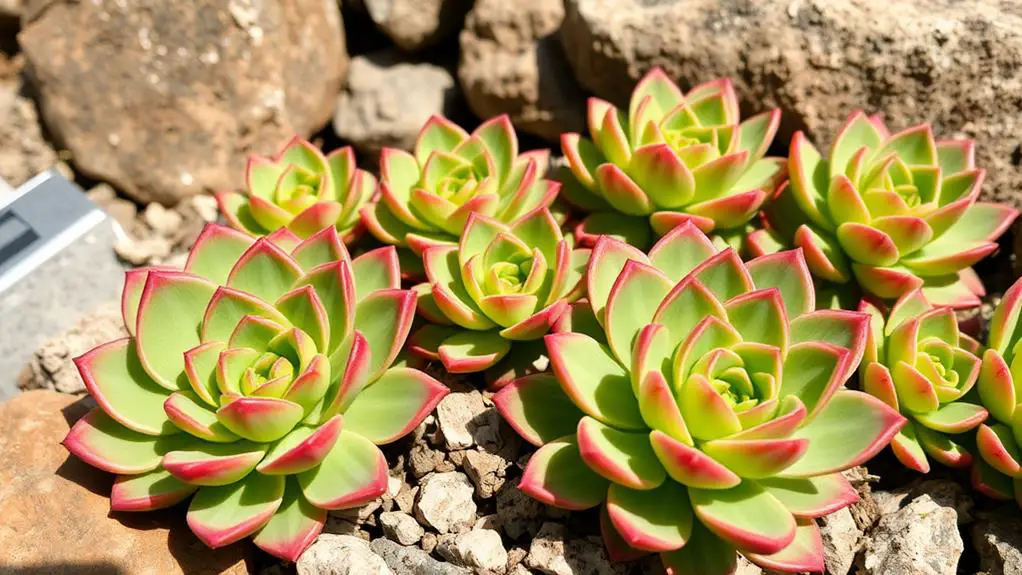
Rosularia platyphylla stands out as a top choice for gardeners in colder climates, boasting the ability to endure temperatures plummeting to -20.02°F (-28.9°C). This cold-hardy succulent thrives in outdoor gardens, providing beautiful green, hairy leaves that form a dense ground cover. Growing up to only 4 inches tall, it's perfect for rock gardens and wall plantings.
You'll appreciate rosularia platyphylla for its resilience and low maintenance needs. It's well-suited for poor, well-drained soils and requires minimal watering, making it a great option if you're looking for a low-effort plant. In summer, this succulent produces small, star-shaped flowers that add a delightful visual interest to your garden.
To help you better understand rosularia platyphylla, here's a handy table:
| Feature | Details |
|---|---|
| Temperature Tolerance | Survives as low as -20.02°F (-28.9°C) |
| Height | Reaches up to 4 inches (10 cm) |
| Ideal Locations | Rock gardens, wall plantings, outdoor gardens |
| Special Features | Well-drained soils, minimal watering, star-shaped flowers |
With rosularia platyphylla, you'll have a beautiful, easy-to-care-for addition to your garden that stands up to harsh winter conditions. Enjoy the peace of mind knowing your garden will stay vibrant year-round.
Pachyveria Pachytoides
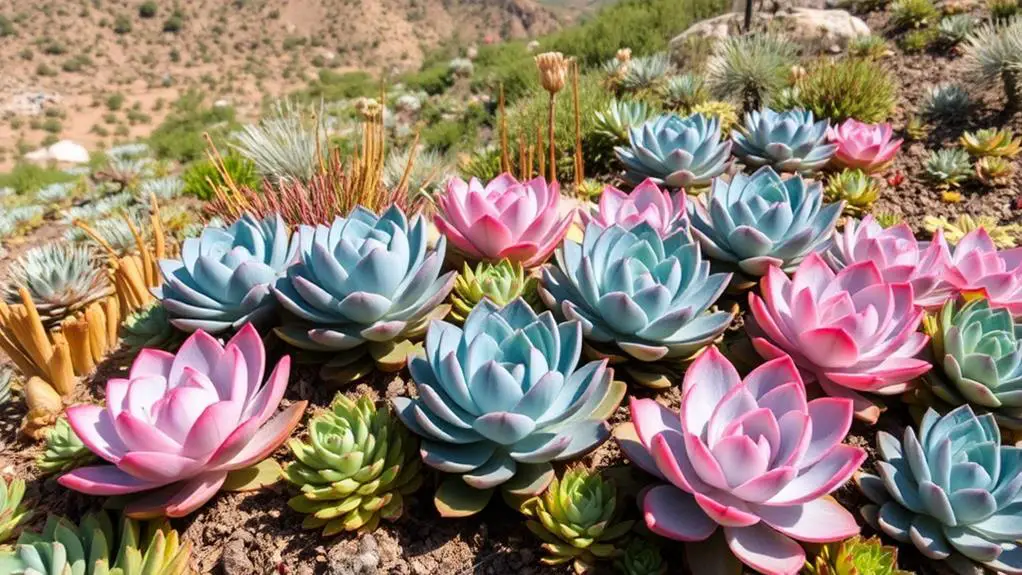
Pachyveria pachytoides is a remarkable cold-hardy succulent that can handle temperatures as low as 14°F (-10°C), making it a solid choice for year-round outdoor conditions.
Its thick, fleshy leaves store water, allowing it to survive in dry environments and bounce back from freezing temperatures in the spring. This resilience makes it a dependable addition to any garden.
To guarantee your pachyveria pachytoides thrives, remember these key points:
- Well-draining soil: This succulent needs soil that doesn't hold water, to avoid root rot.
- Minimal watering: Water sparingly, as too much water can harm it.
- Outdoor placement: It's perfect for rock gardens, container arrangements, or as ground cover.
- Low maintenance: Its hardy nature means less work for you.
Graptopetalum Paraguayense
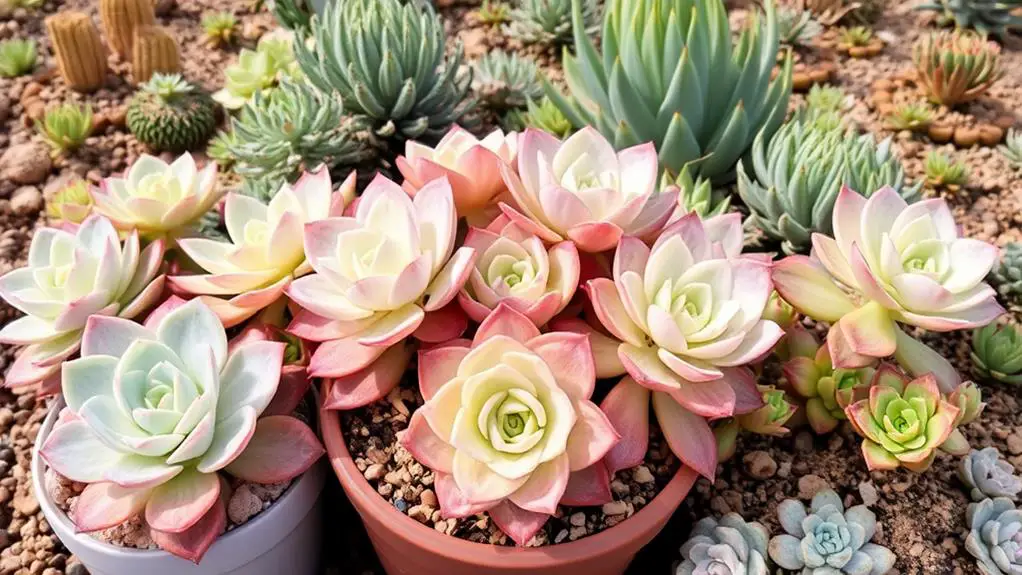
Just as Pachyveria pachytoides impresses with its cold tolerance, Graptopetalum paraguayense, commonly known as Ghost Plant, brings even more resilience to your garden with its ability to withstand temperatures as low as 5°F (-15°C).
This cold-hardy succulent features pale blue-green leaves that form rosettes, often turning pinkish during periods of stress like extreme sunlight or drought.
Graptopetalum paraguayense thrives in well-draining soil and requires minimal watering, making it an excellent choice for low-maintenance outdoor gardens. You won't have to worry much about overwatering, which can be a common issue with succulents. Just let the soil dry out completely before you water it again.
One of the most impressive features of the Ghost Plant is its ability to revive from freezing conditions. Even if the leaves freeze, they can survive frost and regenerate in the spring, ensuring your garden remains vibrant year-round.
Additionally, this plant can be propagated easily through leaf cuttings. Simply place a leaf on the soil, and it will grow roots, allowing you to expand your collection with little effort.
With Graptopetalum paraguayense, your garden will stay beautiful and healthy, no matter the season.
Delosperma Cooperi
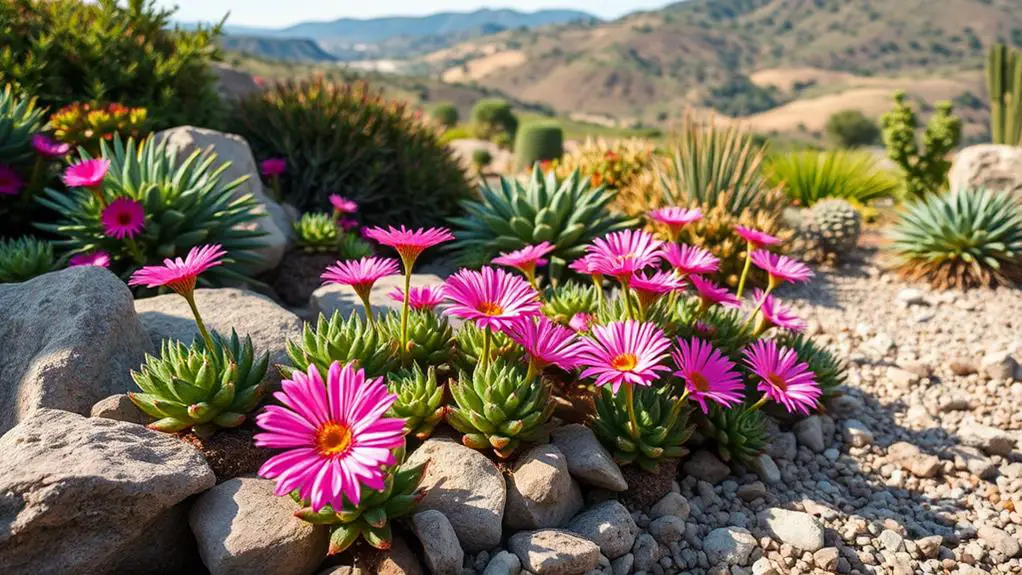
Delosperma cooperi, commonly known as the Ice Plant, is a standout in any garden with its vibrant, daisy-like flowers that bloom in shades of bright yellow or purple.
You'll love how these blossoms attract bees and butterflies, adding life to your outdoor space.
This cold-hardy succulent thrives in USDA hardiness zones 6-10, tolerating temperatures as low as 20°F (-6°C).
Its fleshy, green leaves can turn a striking red or purple in full sunlight, creating a visually enchanting display.
Once established, Delosperma cooperi requires minimal maintenance, making it an excellent choice for busy gardeners.
Here's why you should consider adding this resilient ground cover plant to your garden:
- Cold-Hardy: Delosperma cooperi can withstand cold temperatures, making it perfect for various climates.
- Vibrant Flowers: Its bright blooms add a pop of color and attract pollinators.
- Well-Draining Soil: Prefers well-draining soil, reducing the risk of root rot.
- Full Sun: Thrives in full sun, ensuring healthy growth and vibrant colors.
Incorporate Delosperma cooperi into rock gardens, borders, or xeriscaping designs.
Its dense mats help prevent soil erosion, providing both beauty and function.
Give it a sunny spot with well-draining soil, and watch your garden flourish with minimal effort.
Orostachys Boehmeri
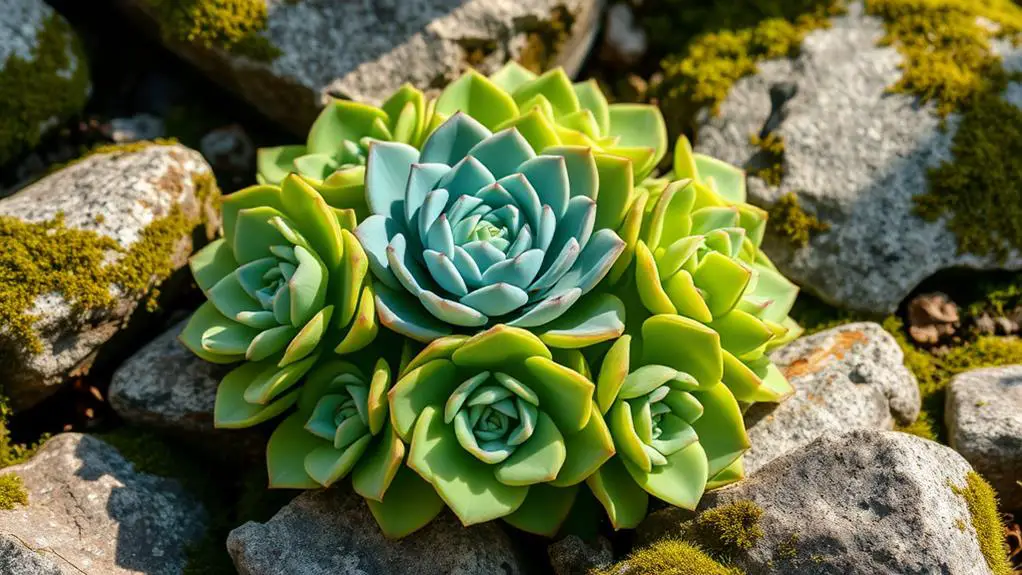
If you're searching for a succulent that can brave the cold, search no more than Orostachys Boehmeri, also known as Chinese Dunce Cap.
This hardy plant withstands temperatures as low as -4°F, and its unique rosette of blue leaves brings a striking look to your garden.
With its resilience, it's perfect for those who want a beautiful, low-maintenance addition to their outdoor space.
Cold Hardiness Level
Orostachys boehmeri, commonly known as the Chinese Dunce Cap, is remarkably resilient with its ability to withstand temperatures as low as -4°F (-20°C). This is one of the best hardy succulents you can have for cold climates. Its cold hardiness level makes it perfect for areas that experience freezing temperatures.
To guarantee your Orostachys boehmeri thrives, consider these key points:
- Cold Hardiness Level: It can survive in temperatures as low as -4°F (-20°C), making it ideal for outdoor succulents in cold climates.
- Well-Drained Soil: This succulent prefers well-drained soil, which helps prevent root rot and other issues caused by excess moisture.
- Resilient Nature: Even after freezing temperatures, Orostachys boehmeri bounces back, maintaining its beauty and health.
- Ornamental Plant: Its circular rosette of blue-green leaves adds visual interest to any garden.
Planting Orostachys boehmeri in rocky areas or crevices will enhance its ornamental value. This durable plant is both biennial and perennial, producing seeds in summer and autumn.
Its ability to recover from harsh conditions and remain attractive throughout the seasons makes it a fantastic choice for any gardener looking to add resilient outdoor succulents to their collection.
Unique Rosette Appearance**
Marvel at the enchanting rosette appearance of the Chinese Dunce Cap, a succulent that truly stands out in any garden. This plant, known scientifically as Orostachys boehmeri, boasts striking blue-green leaves arranged in a mesmerizing circular pattern. Its rosette shape adds an unusual and attractive element to your garden landscape.
Being cold hardy to -4°F (-20°C), the Chinese Dunce Cap can thrive even in harsh winter conditions. It's an ideal choice for gardeners in colder climates who want a resilient yet beautiful plant.
In the summer, you'll be delighted to see unique flower stalks emerging from the rosettes, enhancing its ornamental appeal.
This succulent thrives in well-drained soil and requires minimal maintenance, making it perfect for low-water landscapes. You won't need to fuss over it, allowing you to enjoy more time admiring its beauty.
Use it in rock gardens or as ground cover to fill gaps and create a stunning textural contrast with other plants.
With the Chinese Dunce Cap, your garden gains a hardy, low-maintenance plant that not only survives but also shines through the seasons, adding unique visual interest year-round.
Frequently Asked Questions
Are There Any Cold Hardy Succulents?
Yes, there are cold hardy succulents. Varieties like Sempervivum, Sedum, Pachyveria pachytoides, and Rosularia platyphylla can survive freezing temperatures, making them ideal for various climates. Knowing your hardiness zone helps in choosing the right plants.
What Is the Easiest Succulent to Grow Outside?
The easiest succulent to grow outside is Sempervivum (Hens and Chicks). It's extremely cold-hardy, tolerating temperatures as low as -30°F, and thrives in various soil types. You'll find it resilient and low-maintenance for outdoor gardening.
Will Succulents Survive Cold Winters Outside?
Yes, succulents can survive cold winters outside if you choose hardy varieties like Sempervivum or Sedum. Guarantee they're planted in well-draining soil and in the right hardiness zone. They need minimal water during dormancy.
Are There Perennial Succulents?
Yes, there are perennial succulents. You'll find species like Sempervivum and Sedum, which can survive cold winters and thrive for multiple seasons. They require minimal maintenance and are perfect for adding year-round greenery to your garden.
Conclusion
You've got plenty of hardy outdoor succulents to choose from, no matter where you live. Whether you're in a colder climate or a warmer region, these plants will thrive with minimal fuss. Sempervivum, Sedum Spurium, and Rosularia Platyphylla handle the cold, while Pachyveria Pachytoides and Graptopetalum Paraguayense love the heat. Delosperma cooperi and Orostachys boehmeri offer beauty and simplicity. Start planting today and watch your garden transform into a vibrant oasis!


